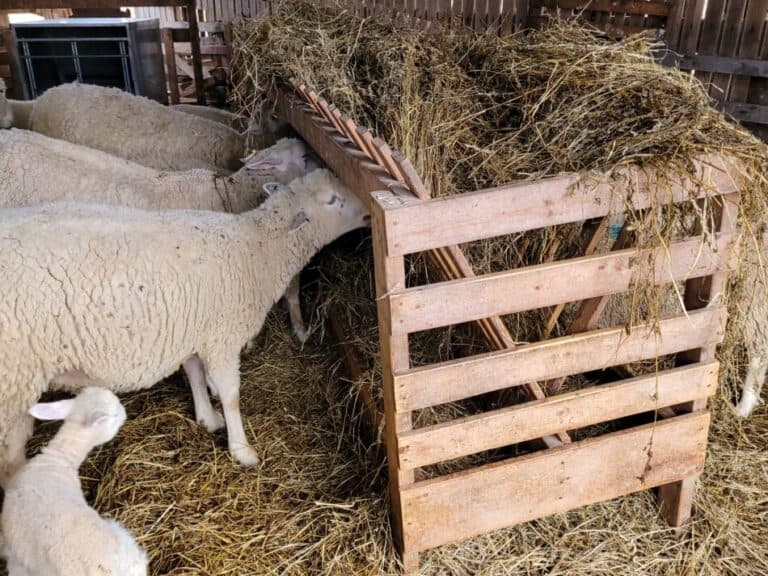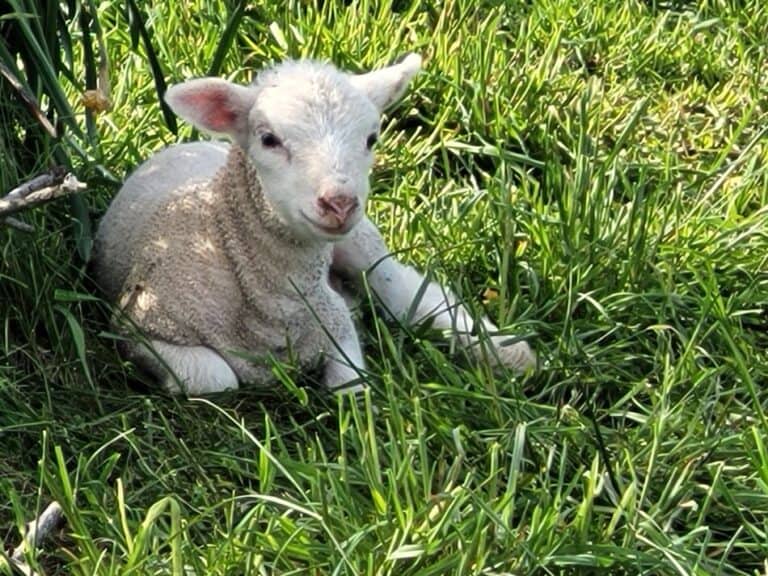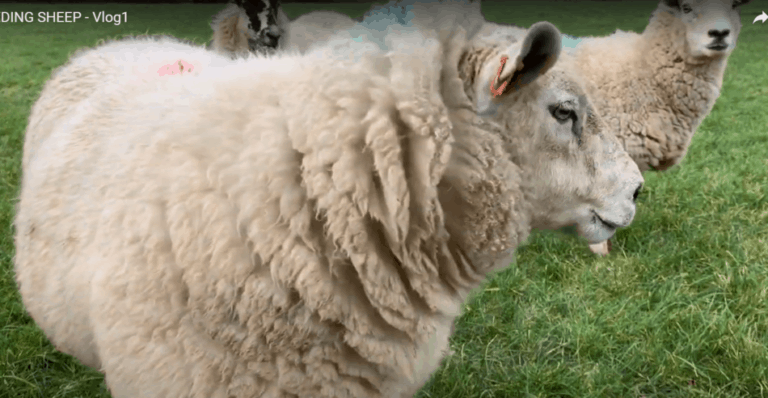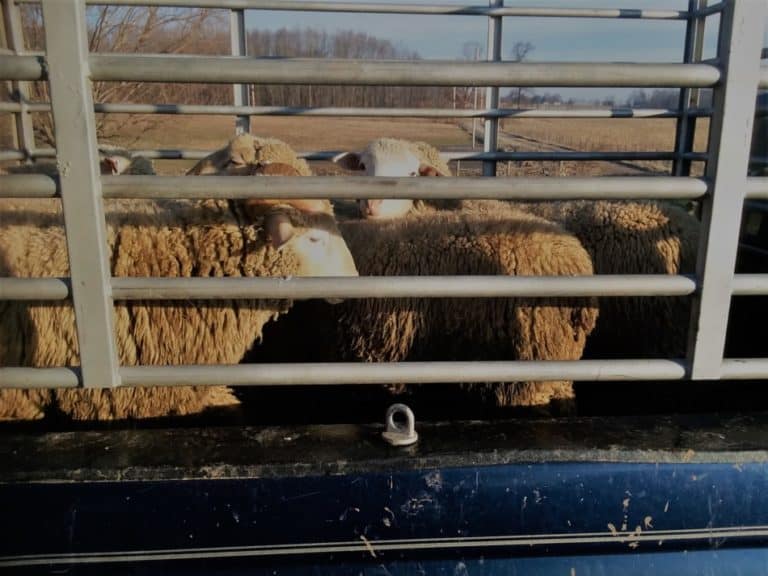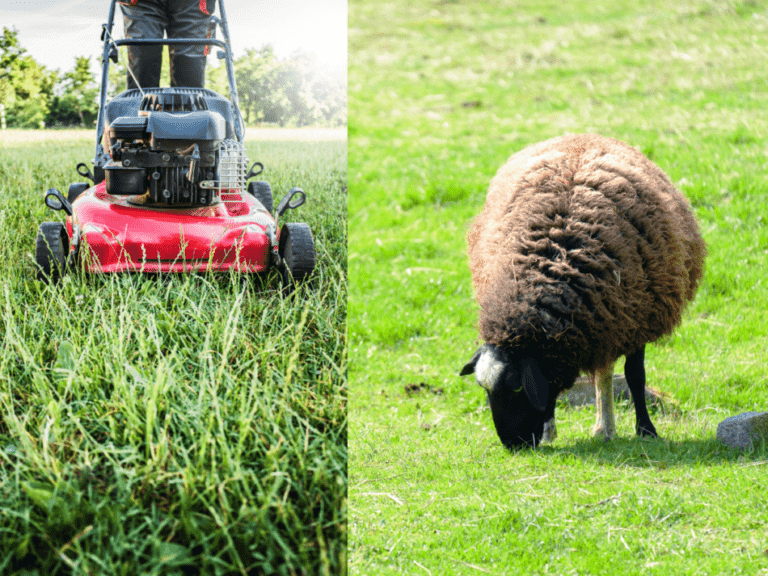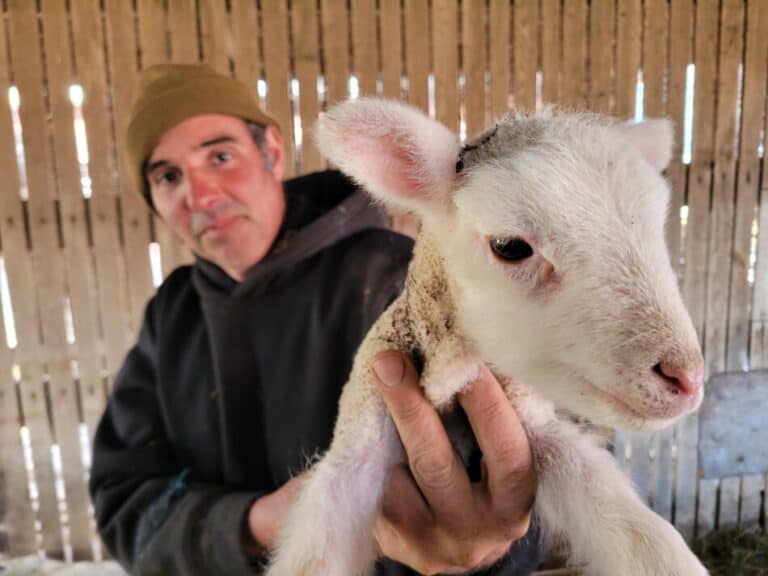111 Facts About Sheep: Beginner friendly basics
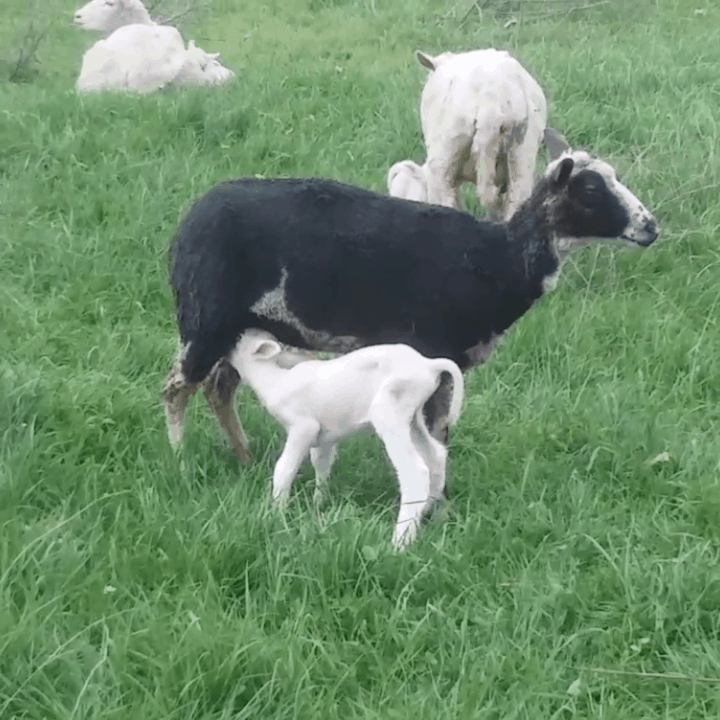
Want to know more about sheep, but are not sure where to start? I’ve got you covered.
We’ll go over all the terminology and production ideas related to sheep, starting with the very basics!
Sheep are ruminants.
Sheep have a special design to their stomach that allows them to eat and grow well on grass and other forages.
They can eat and digest things an animal with a simple stomach could not digest.
How Many Bales Of Hay Do Sheep Need? goes over how to figure up the winter hay needs for your flock.
The stomach of a sheep has four compartments.
Sheep like other ruminants have one stomach that is divided into four sections. Each section has a special function.
Understanding The Ruminant Animal Digestive System is an article from Mississippi State University Extension goes over the specifics of why ruminants are different digestively than animals with a simple stomach, like pigs or people.
Sheep have many small organisms in their stomachs.
Oddly enough, so do you! These small organisms help you and the sheep digest food.
When you take probiotics you are reseeding your gut with these digestive organisms.
The word sheep is used for many animals or just one animal.
Similar to the word deer, when speaking of sheep it is the same word whether you mean many sheep or just one.

Sheep eat grass.
One of the main food sources for sheep is grass. Since grass can grow nearly anywhere, sheep that eat the grass can be nearly anywhere.
How To Select A Grass Based Sheep Flock gives you tips on getting started with pastured sheep.
Sheep also eat other forages.
Forages are plants that an animal would eat. This could be hay, clover, alfalfa, and many others including weeds, in addition to the grass.
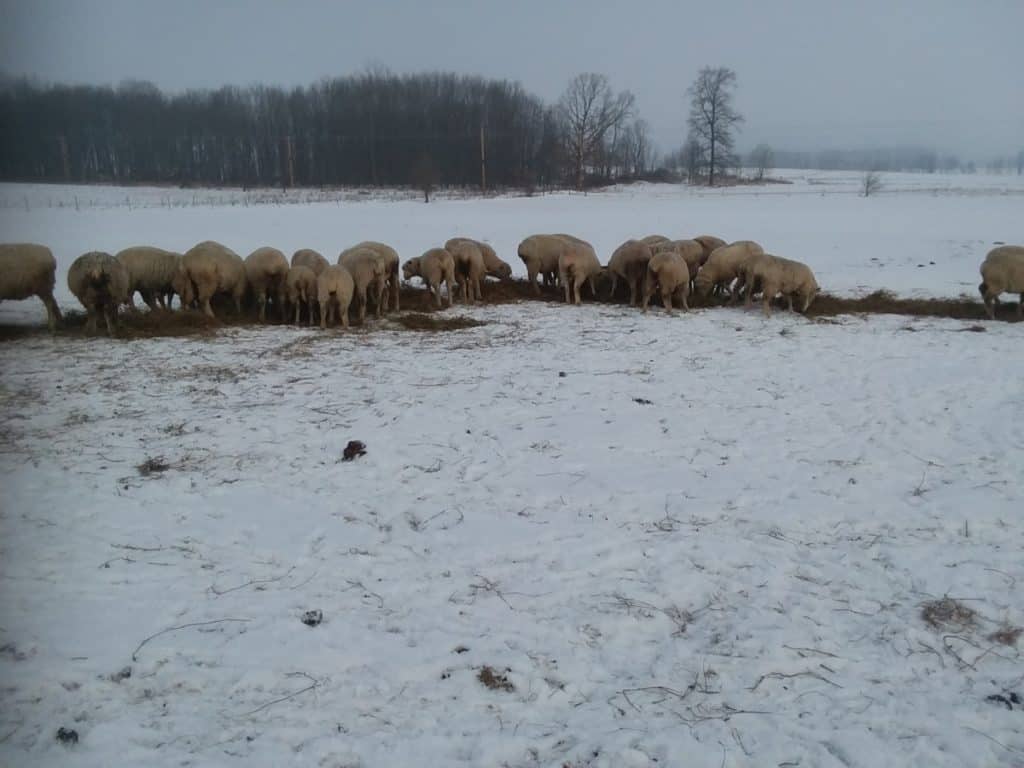
Sheep can travel long distances looking for food.
Since a sheep is mobile, it can travel to get the day’s food. This is exactly how large herds of other grazing animals like buffalo get their food.
Sheep turn grass into meat and wool.
Sheep and other grass eating livestock enable people to use areas of land to feed and clothe ourselves.
Grazing sheep on land improves fertility of the area.
Many areas are fragile and have limited nutrients. When carefully grazed with sheep these areas will improve in fertility and grow more grass or other forages the next year.
Sheep can be used to manage the grass in orchards.
Rather than mowing around all the trees, some orchard owners prefer to use sheep to eat the grass in between the trees.
This will control grass growth in the pathways. add fertility (manure) and keep down weeds.
Do Sheep Eat Fruit Trees? shows you the times when sheep are safe around trees and when they are not!
In wildfire prone areas, sheep are used to eat down weeds.
In Utah, flocks of sheep are used to eat weeds that are likely to fuel a fire in a fire prone area.
Less to burn equals a lessened likelihood of the fire spreading as quickly.
Poorly managed grazing sheep can reduce fertility.
Livestock must be looked after and moved to a new area when the grass they are on is eaten.
It is the job of the shepherd to monitor the grass and land in order to move the flock appropriately.
Do Sheep Ruin Pastures? goes much more deeply into this subject.
A group of sheep is called a flock.
Most sheep are kept together in a group called a flock. Sheep like to be with other sheep.
Flock size can vary considerably.
Some flocks are small farm or hobby flocks with just a few sheep. Other flocks like in the western U.S. or at the sheep stations in Australia are enormous with huge numbers of sheep.
The largest sheep flocks in the U.S. are California.
This flock was originally from Washington state but moved to California to use the sheep for wildfire control.
The largest number of sheep in the world are in China.
The country with the most total sheep is China. Next in total head of sheep is Australia, followed by India, Sudan and Iran.
Sheep like to be in a flock.
Being in the group helps them feel secure. Sheep like to follow other sheep around.
Being in a flock also helps protect the sheep from predation. A sheep by herself is easy to catch for hungry predators.
Some breeds flock together better than other breeds.
Certain breeds of sheep like Merinos will flock together well. This makes them easier to move and helps them stay safe from predators.
Range sheep tend to flock together well.
Sheep like to follow other sheep.
It is the basic nature of the sheep to want to follow other sheep. It makes them feel safe to be with a group.
In a group only one sheep needs to spot a predator and all will be alerted to run.
An adult female sheep is called a ewe.
Sheep are adults when they turn one to two years old. Once a ewe lamb has a baby she is considered to be a ewe.
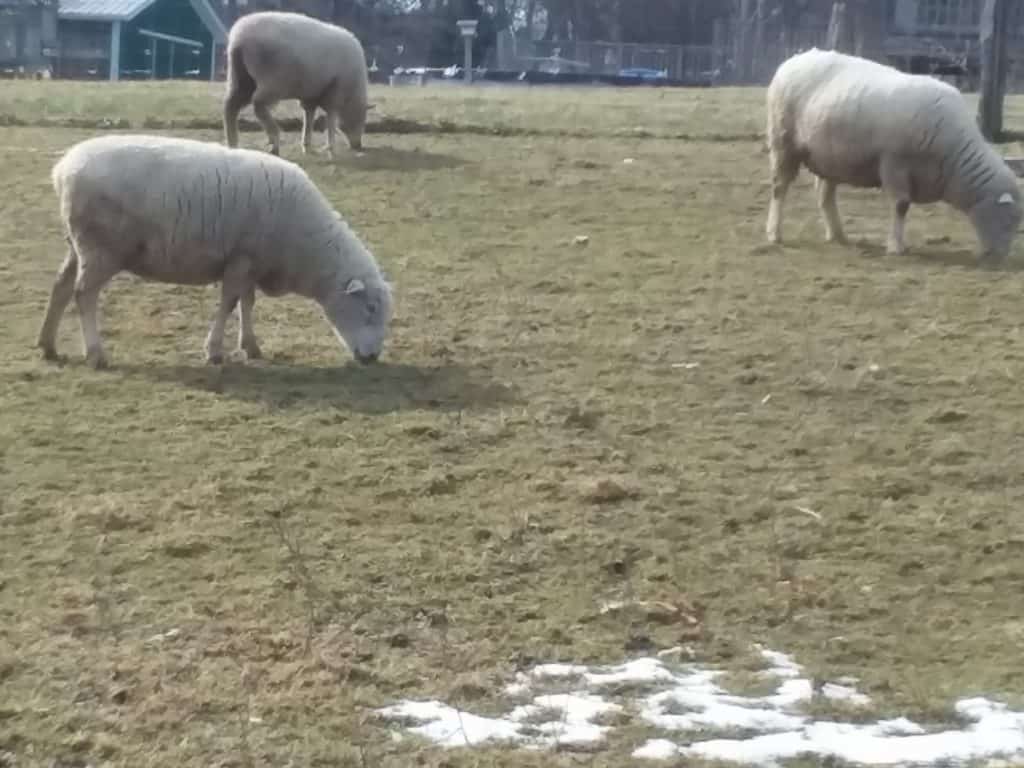
An adult male sheep is called a ram.
Rams are the breeding male sheep kept with the ewes. Rams tend to be bigger than ewes.
A castrated male is called a wether.
Wethers are generally kept only as market lambs. However, breeds that have very valuable fleeces sometimes keep wethers in the flock as fiber producers.
Sheep will be pregnant for 5 months.
Pregnancy is called gestation. The gestation length in sheep is 5 months or 152 days.
A ewe can have multiple lambs.
Number of lambs depends upon the breed of sheep and the condition of the ewe at breeding. Normally, most shepherds want their ewes to have twins.
Breeds like Finnsheep and Romanov are famous for having many lambs at once.
Some breeds like Finnsheep and Romanov are famous for having a litter of lambs-meaning four up to nine lambs at one birth.
Sheep are mammals.
Female mammals produce milk for their babies once the baby is born. Sheep are mammals as are humans, dogs, cattle and many other animals.
Ewes produce milk for their lambs.
Until the lambs are born the ewe will not produce any milk. This makes sense because the milk is for the baby. When the lambs are born the milk starts filling the udder.
Some farmers milk a flock of sheep.
There are sheep dairies in the world that milk many sheep just like cow dairies milk many cows.
Sheep milk is used for cheese.
Roquefort cheese is a famous cheese from France that is traditionally made from sheep milk.
Sheep dairies are not common in the U.S.
Now sheep dairies are very uncommon in the U.S. There is at least one that I am aware of in New York state.
A ewe knows which lambs in the flock are hers.
A ewe can tell which lambs are hers out of all the lambs in the flock. She smells her lambs when they come up to her.
She can also tell the voice of her lambs from the voices of others.
Only the ewe will parent the lambs.
The ewe is the only parent the lambs will have. Rams do not help with care of the lambs.
She will only let her babies nurse.
Ewes only let her lambs nurse. Sometimes other lambs, usually older lambs, realize that all ewes have an udder that they can steal milk from.
She keeps other lambs away so there is plenty of milk for her babies.
A lamb without a mom to take care of it is called an orphan.
Sometimes a lamb is not taken care of by it’s mom or the mom dies. Lambs without a mom to take care of them are called orphans.
Some ewes will decide to take care of a baby that is not hers.
Sometimes a ewe will want a lamb that is not hers. This is why most sheep raisers will put the new born lambs into a small pen with their mom.
The small pen for new lambs and their mom is called a lambing jug.
A lambing jug is a small pen with hay and water for the ewe. There is no food for the lambs because new born lambs only drink milk from the ewe.
The new family comes out of the jug in 24-48 hours.
The time spent in the jug allows the lambs to bond with their mom. Lambs and their moms will be let out 24-48 hours later, as soon as they are strong enough to keep up with the rest of the group.
New lambs are wobbly.
A new lamb needs a few days to get the hang of working it’s legs.
At first they are very unsteady but in a day or two they can run pretty fast. At least fast enough that they are hard to catch!
Sometimes the lamb will die.
Sometimes a ewe has a lamb that dies. This is a sad thing and upsets the ewe. She wants a lamb and will search to find it.
Some ewes will take care of another lamb.
Shepherds can give her a new lamb by penning her up with a lamb that is not her own and seeing if she will take care of it.
Some ewes will do this others will not, in fact some ewes are mean to the lamb.
Getting a ewe to take care of a lamb that is not hers is called grafting.
If the ewe takes the lamb as her own the lamb has been grafted to a new mom.
Grafting an orphan lamb to a ewe without a lamb is the best way to help the ewe and the lamb.
A lamb that is not successfully grafted will be a bottle baby.
Lambs that are not able to be grafted will be fed milk with a bottle. This requires feeding them around the clock just like a human baby.
Bottle lambs end up being very friendly since they have learned that people coming means food.
Bottle lambs are fed milk replacer.
Milk replacer is a powdered milk substitute that is used for orphan lambs, Just like formula for babies. Lambs can also be fed cow’s milk in their bottle.
Lambs need to be with their moms for two months.
Lambs need their moms for two months at least. While they are drinking milk from the ewe they are also picking around at the food they see her and the other sheep eating.
Lambs need time for their digestive system to work well enough so they can get all of their nutrients from normal sheep food like grass.
A lamb that doesn’t need milk from it’s mom anymore is referred to as being weaned.
Weaning is a natural process that happens with all animals that need parents to provide food for them.
When an animal can eat enough calories to grow without milk from a parent the animal is weaned. Weaning happens for all mammals, including humans.
A sheep is called a lamb until it is 12 months old.
Once a sheep reaches one year of age it is officially no longer a lamb.
If you see a sheep at an event, like the state fair, or for sale online or at an auction and it is called a lamb it is under one year old.
Sheep only have teeth on the bottom jaw.
Sheep have one row of teeth on the bottom jaw. The top jaw has no teeth.
The age of the sheep can be determined by looking at the teeth.
Sheep teeth come in at certain ages. The front two teeth grow in then every year another set of two grows in.
Sheep replace baby teeth just like people do.
Lambs can grow to full size on grass and mom’s milk.
Lambs can grow to full size eating just grass and milk from mom. Lambs love a snack of grain or really nice hay but they don’t need it to live.
Sheep should have a salt block.
Salt blocks help the sheep to regulate her own salt intake. Sometimes she needs more than she is getting from her diet so she can choose to get more by licking the salt block.
Sheep need water all the time.
Even though sheep live in places all over the world that are very dry, they still need to have water available all of the time.
Sheep can eat snow to instead of drinking water.
If your sheep are in an area with snow they can eat the snow instead of drinking water.
Our sheep have access to a creek for water but sometimes they choose stay up closer to the barn for a few days and eat snow instead.
Lambs that are fed supplemental grain will grow faster.
Some shepherds choose to feed their lambs some grain or really nice hay to help them grow faster. This extra grain is called supplemental grain.
If no grain is fed the lambs will still grow it will just take longer.
Lambs are fed in a creep feeder.
Lambs and ewes both like to eat the special feed, but only the lambs should be getting it. So how are the ewes kept away from the extra feed?
A creep feeder is used to let the smaller animals in (lambs) but keep out the bigger ones (ewes). The creep feeder can be a gate to a small area or a self contained pen.
Sheep can live in many areas.
Sheep can and do live in many different areas all over the world.
Sheep live in cold places like Iceland and they live in hot places like the Australia. Some sheep live in flat landscapes others in areas that are very rugged like mountains.
Sheep can become friendly.
When sheep are used to people they can become friendly. Most sheep will never be as friendly as a dog though.
They can tell the difference between their normal caretaker and someone new and are always leery of the new person.
Some sheep breeds are more nervous than other breeds.
Just like any other animal, some sheep are more friendly than others. It follows then that some individuals have a more nervous temperament.
Generally, sheep that have had to fend for themselves are less calm around people. This is just a natural trait since the more wary sheep were more likely to survive.
Sheep startle easily.
As a normal part of growing up in a flock one sheep alerts others to danger. When a ewe sees something suspicious she will run first and think later.
Sheep breeds easily cross.
Any breed of sheep can be mated with any other breed of sheep. The lambs born from this cross will not be purebred. They will be a hybrid.
A cross of two or more breeds is called a hybrid.
Crossing two or more breeds of sheep or other animals together results in the offspring being a hybrid. This means they are a genetic mix.
Cross bred sheep are very common.
Cross breeding sheep is a common way to put the ideal traits of each parent into the baby.
A cross bred lamb performs better, hardier and faster growing, than a purebred lamb of either of the parent breeds.
The famous Mule sheep of Great Britain are cross bred ewes.
Some sheep can breed year round.
Multiple sheep breeds will breed and therefore lamb year round. Dorset sheep are popular in the U.S. specifically because they will lamb year round.
Year round breeding capability of sheep spreads out the income for the farmer.
When the sheep can breed year round it also means there are lambs year round to sell.
This makes better use of the barn space and allows the farmer to spend more time with the new moms and babies to make sure they do well.
Other sheep are seasonal breeders.
Most sheep breeds are seasonal breeders. This means they will all come into heat at the same time of year so they will lamb in the nicer weather.
Having lambs only in the spring means that the lambs will all be at a bigger size at the start of winter, so they will be able to take care of themselves in the harsh weather.
Seasonal breeding is common in wildlife for example the whitetail deer are seasonal breeders.
Texas is the state with the most sheep.
Texas has more sheep than any other state with 740,000 head.
Second in total sheep numbers is California, then Colorado, Wyoming, Utah, South Dakota, Idaho, Montana, Oregon and Iowa.
A sheep ranch will often hire full time shepherds.
The larger ranches need shepherds to work with the sheep full time.
Professional shepherds live with the sheep.
Some ranches are so big the shepherds follow the flock around on the range, basically living right along side the sheep and work on horseback.
These shepherds grew up with sheep.
Many of these nomadic shepherds grew up in another country where they learned to live and work with sheep.
Sheep breeds primarily kept for meat production are called meat breeds.
Meat breeds have fast growing meaty lambs. These are the type of sheep that you would see at a market lamb show during the fair.
Most meat breeds have wool, it is just not as nice as the wool from wool breed sheep.
The most popular meat breed in the U.S. is the Suffolk.
The Suffolk sheep is a stylish meat breed that has a black head and legs. This is the lamb most commonly seen in market lamb classes at the fairs.
The most popular meat breed in the world is the Merino.
While Merino is not considered a meat breed of sheep it is the most popular breed of sheep in the world so it will also be the breed most eaten.
Wool breeds were kept primarily for their wool production.
Wool production was the main focus of breeds like Merino.
Wool breeds are not as chunky as meat breeds but tend to be better in harsher environments.
Wool sheep take less feed to maintain their bodies and grow slower so they can range for calories.
Keeping sheep just to sell the wool will not pay well in the U.S.
Wool was a very valuable commodity around 200 years ago. Fortunes were made selling wool.
At the end of WW II wool started to be replaced by other options. Now there are multiple other raw material choices from which to make fabric.
In harsh areas wool sheep would still provide income.
In harsh areas or places where people move with the flocks sheep wool and meat will give them a way to provide an income for their families and provide for themselves at the same time.
The most popular wool breed in the U.S. is the Rambouillet.
The Rambouillet is the most common commercial sheep in the U.S. It is used as a range sheep since it lives for a long time and has a strong flocking instinct.
The most popular wool breed in the world is the Merino.
Merino sheep make up more than half of the world’s sheep population. Merino’s have fine wool, are adaptable, good foragers and have a strong flocking instinct.
Sheep kept for both meat and wool are called dual purpose breeds.
Dual purpose breeds are not extreme in wool production or carcass, but do both reasonably well.
Dual purpose sheep are very popular for the small farm or a person just getting started with sheep since these are generally easy care animals.
The most popular dual purpose sheep in the U.S. is the Dorset.
Dorsets are the most popular white faced sheep breed in the U.S. Dorsets are known for prolific lambing, good meatiness, and are normally polled (no horns).
Most sheep in the U.S. are kept for meat.
In the U.S. most people are keeping sheep for meat purposes, generally to produce and sell market lambs.
Occasionally, shepherds in the U.S. keep certain sheep for the fleece.
There are a few farms in the U.S. that sell specialty fleeces to handspinners and crafters.
These are sheep with a unique fleece that is prized by the hand crafting fiber artist.
Worldwide, sheep are commonly kept for wool.
Over the rest of the world sheep are kept for wool. Sheep are popular in places that are not easily to farm for field crops so sheep provide a way for people in these areas to grow their own fiber and meat.
Wool characteristics are inherited.
Just like you inherited the color of your eyes from your parents you also inherited the color and texture of your hair. The same goes for sheep.
A lamb who’s parents had soft wool will have soft wool also. If the lamb’s parents have natural colored wool so will the lamb.
Some sheep are natural colored.
Natural colored means that the wool of the sheep is naturally a color other than white. Or it could be a mix of colors.
There are many different wool colors, like an earth toned rainbow.
Non white wool is discouraged against for commercial wool production.
Wanting to purchase only white wool makes sense, since only white wool has the most options for the end user especially since it can be reliably dyed.
Natural colored wool is popular with crafters and handspinner and weavers.
Naturally colored wool sells at a high price to people looking for a special color or texture of wool for creating handmade items.
Wool is graded.
Wool is separated off into catagories based on the thickness of the individual fibers of wool. Each thickness range is called a grade.
Wool thickness is measured in microns.
A fiber of wool is measured to determine the thickness in microns. This will tell the best uses of the fleece.
Wool is graded into fine, medium and coarse.
Each grade of wool has a different purpose that it will be best suited to.
Fine wools are soft.
Fine wools are used to make fabrics that can be worn next to the skin, like baby clothes or a delicate sweater.
Medium wools are versatile.
Medium wools are the workhorse class of wool. They are easier to work with and used to everyday wear like hats and sweaters.
Coarse wools are very durable.
Course wools are also called carpet wools. These wools are tough and can handle tons of abuse so are used in weaving rugs or other heavy duty items.
Some sheep have an in between wool grade.
Some sheep have wool that is firmly in between grades so it is called medium-fine or medium-course.
Most sheep need shorn once per year.
Most sheep in the U.S. are shorn one time per year. If you are looking for more information on shearing sheep consider reading my article Why Do Sheep Need Shearing.
Some sheep need shearing twice per year.
If the sheep has very fast growing long fibered fleeces then it will be shorn twice per year.
Cotswold and Wensleydale sheep are examples of sheep with incrediably long fleeces. The fleece will grow for the whole year but it will not be as valuable to the end user in anything less than top condition.
Shearing sheep requires clippers.
Shearing sheep is done with a set of clippers made like the clippers used to cut hair at the barber shop just much bigger.
Some people use hand shears that operate like scissors to trim up show sheep but these hand shears are rarely used to shear an entire sheep.
Farmers can shear their own sheep.
Plenty of sheep farmers will shear their own sheep. We shear ours in the spring every year.
Many sheep farmers hire a crew to shear their sheep.
Many farmers who have a large flock of sheep, or just would rather hire some one else, pay a crew of professional shearers to come each year and shear their sheep.
A shearing crew will travel all around the country.
Shearing crews travel the country to shear all the big flocks of sheep. The crew moves from one farm to the next quickly since all the sheep need shorn before summer.
Hair sheep do not need shearing.
Hair sheep do not have wool, instead they have hair like a goat.
Hair sheep are becoming more popular because in some areas of the country it is hard to find someone to shear sheep for you.
Hair sheep do grow a small amount of wool.
In the winter, hair sheep will grow a small amount of wool to help insulate their bodies from the harsh weather.
Once spring comes the sheep will naturally shed the winter coat, short wool and all.
Wild sheep do not need shearing.
Just like domestic hair sheep wild sheep do not need shearing. Their hair naturally falls out at the changes of the season like a dog shedding it’s hair.
Sheep sleep laying down.
When a ewe wants to rest for the night she lays down to go to sleep. The flock will all sleep together at night, even if they were spread out to graze during the day.
A sheep will eat all she needs then rest.
Since a sheep is a ruminant, she will eat a bunch of forage at one time then when she is full she will lay down to rest.
A sheep will chew her cud while resting.
While relaxing the sheep will chew her cud. Since she ate the forage so fast earlier it needs more chewing now that she has the time.
Chewing her cud is one of the keys to her being able to eat and digest food we could not digest.
Chewing her cud helps her digest her food.
Cud is a little bolus of grass that the sheep brings back up from her stomach to her mouth to thoroughly chew.
This will break down the fibers of the forage so her digestive system will have access to all the nutrients in the food.
Sheep need some room.
While sheep are not a large animal they do need some room to walk around in.
Sheep need buddies.
A sheep does not like to be by herself. She is a flock animal so she needs a few friends to live with her.
Sheep do not potty train.
Sheep are super cute, especially lambs! They are a poor choice as an indoor pet since they do not potty train and as listed above need to be with friends.
Sheep can be purchased at a livestock auction.
Weekly livestock auctions sell sheep year round. Purchasing a few sheep at the auction is an option. Auctions are fun.
We enjoy going to them and sell nearly all of our sheep through the auction market.
However, auctions are buyer beware. This is not the best option for a beginner.
Sheep to start your flock should be purchased at a farm.
If you are new to sheep it is best to buy them directly from a farm instead.
Direct on farm purchase of your livestock is the best way to get animals that will work well for you.
Additionally, buying from a sheep farmer gives you someone to call when you have questions, and when you are new you’ll probably have a ton of questions.
Related Questions
Are sheep the only animal that needs yearly shearing?
All fiber animals need to be shorn at least once per year, in addition to sheep this would include Angora goats and alpacas as examples.
Are most sheep male or female?
Sheep flocks are mostly females. The lambs are born male or female in equal numbers but generally the male lambs are all sold, while some of the female lambs are kept to join the flock as adults.
